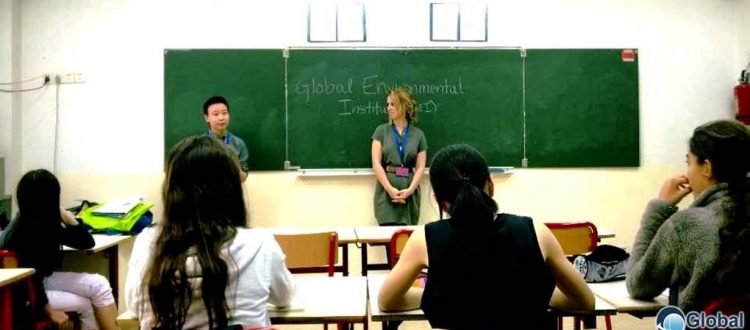Teaching Development Methodology Through Cookies at French International School of Beijing
Poverty alleviation and developing regions are two topics covered in the middle school Geography class at Beijing’s French International School. To bring this lesson to life, GEI was invited to share our work in Myanmar, especially in the Thanbayarkhon (TBK) village, and how we facilitate cooperation between the Myanmar government and Chinese government to promote a market sustainable model of aid.
On Thursday, April 21, Program Officer and Assistant to the Executive Director, LI Jin, and Communications Officer, Kendall Bitonte, arrived at the school with a lesson plan and cookies in hand – what a perfect way to ring in 2016 Earth Day!

GEI Staff, Lin JI (L) and Kendall Bitonte (R) introduce themselves and GEI to the middle schoolers – GEI 2016
From a Cookie to a Solar-Powered Water Pump
BEIJING (Apr. 21, 2016) – Middle schoolers in the French International School of Beijing (Lyceé Français International de Pékin) and Myanmar’s Thanbayarkhon (TBK) Village school are separated by 3,217 kilometers, a half hour of time zone difference and a world of socio-economic disparity. In fact, middle school is the highest level of education in TBK village, while these Beijing students are on the other hand being prepped for high school and college; TBK classrooms have dirt floors and lack electricity while the French International School is moving to a new facility next month; finally, TBK children live a simplistic life while students in Beijing have all modern amenities at their fingertips.
But on Thursday, April 21, the two students’ lives crossed paths thanks to creative curriculum planning by geography teacher, Antoine Silva, and a special visit from GEI.
In just one hour, these students learned that there’s more to poverty alleviation than simply donating money or donating technology. Using the delicious cookie teaching tools, the students learned that the method of how a developing country provides aid is the key to actually making a difference.

The Donation Model: 5 Cookies, 5 Students and some important concerns
After a brief introduction to GEI and the Chinese NGO’s basic work, GEI Staff members, Lin JI and Kendall Bitonte, invited five students to the front of the classroom. The students were designated as follows: one as the developed country, one as the NGO, one as the government of a developing country and two as the developing country’s poor villagers.
The ‘Developed Country’ was then given five cookies, which should be donated to the villagers. The Developing Country kept a cookie, gave four to the NGO; the NGO kept a cookie and gave three to the Developing Country Government, who in turn kept one and distributed the rest to the villagers.
As the students enjoyed the cookies the class discussed the pitfalls of this model.
What happens when all the cookies are gone? Does the Developed Country want to give more? What if the Developed Country decided to take back all of the cookies?
Understanding that the cookies could represent money, renewable energy technology or other supplies, the students quickly grasped the unsustainability of donation.
 JI Lin explains the difference between the Donation Model of aid and Market Mechanism model – GEI 2016
JI Lin explains the difference between the Donation Model of aid and Market Mechanism model – GEI 2016
The Market Mechanism Model: 5 Cookies, Some Chocolate, 5 Students and New Hope
The second half of the class was invited up to the front of the classroom to demonstrate the market mechanism model. The students were again designated as a Developed Country, NGO, Developing Country Government and Villagers, but for this model, the Developing Country was given cookies, and the NGO was given chocolate. As the Developing Country passed cookies to the NGO, the NGO passed cookies and chocolate to the Developing Country’s Government, who then gave all the chocolate and some cookies to the Villagers.
With the chocolate symbolizing an ingredient of the cookie, the students quickly understood that now the villagers could make more cookies, and then sell the extra cookies to make their own money. In this way, the problems of dependency and conflict were solved and a trust between the villagers and the developing country’s government and a new local market was built.

Students enjoy our video of the TBK village project; they especially liked listening to the Burmese voice over – GEI 2016
GEI’s Promotion of the Market Mechanism Model in Myanmar
As the students enjoyed their sweet snack, Kendall and Lin shared the video of our project in Myanmar and taught them about the specific development and our project. In fact, in 2015, GEI successfully completed a pilot project in Myanmar that exemplified the Market Mechanism Model: in addition to donating 193 Solar Home lights and 180 Biomass cook stoves, which provided immediate relief and improved livelihoods and health, we also set up a solar powered water pump that provided clean water and supports a community development fund for the village.
In this way, the students saw that the market mechanism can work to solve real problems. Plus, we explained that GEI’s work helped to build cooperation between Myanmar and China and that this model will be disseminated in more villages throughout Myanmar!

